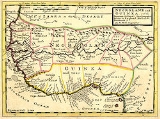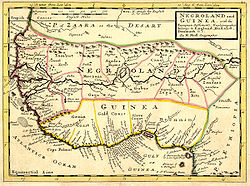
Slave Coast
Encyclopedia

Togo
Togo, officially the Togolese Republic , is a country in West Africa bordered by Ghana to the west, Benin to the east and Burkina Faso to the north. It extends south to the Gulf of Guinea, on which the capital Lomé is located. Togo covers an area of approximately with a population of approximately...
, Benin
Benin
Benin , officially the Republic of Benin, is a country in West Africa. It borders Togo to the west, Nigeria to the east and Burkina Faso and Niger to the north. Its small southern coastline on the Bight of Benin is where a majority of the population is located...
(formerly Dahomey
Dahomey
Dahomey was a country in west Africa in what is now the Republic of Benin. The Kingdom of Dahomey was a powerful west African state that was founded in the seventeenth century and survived until 1894. From 1894 until 1960 Dahomey was a part of French West Africa. The independent Republic of Dahomey...
) and western Nigeria
Nigeria
Nigeria , officially the Federal Republic of Nigeria, is a federal constitutional republic comprising 36 states and its Federal Capital Territory, Abuja. The country is located in West Africa and shares land borders with the Republic of Benin in the west, Chad and Cameroon in the east, and Niger in...
, a fertile region of coastal Western Africa along the Bight of Benin
Bight of Benin
The Bight of Benin is a bight on the western African coast that extends eastward for about 400 miles from Cape St. Paul to the Nun outlet of the Niger River. To the east it is continued by the Bight of Bonny . The bight is part of the Gulf of Guinea...
. In pre-colonial time it was one of the most densely populated parts of the African continent. It became one of the most important export centres for the Atlantic slave trade
Atlantic slave trade
The Atlantic slave trade, also known as the trans-atlantic slave trade, refers to the trade in slaves that took place across the Atlantic ocean from the sixteenth through to the nineteenth centuries...
from the early 16th century to the 19th century.
Other West African regions historically known by their prime colonial export are Gold Coast
Gold Coast (British colony)
The Gold Coast was a British colony on the Gulf of Guinea in west Africa that became the independent nation of Ghana in 1957.-Overview:The first Europeans to arrive at the coast were the Portuguese in 1471. They encountered a variety of African kingdoms, some of which controlled substantial...
(modern-day Ghana
Ghana
Ghana , officially the Republic of Ghana, is a country located in West Africa. It is bordered by Côte d'Ivoire to the west, Burkina Faso to the north, Togo to the east, and the Gulf of Guinea to the south...
), Ivory Coast (modern-day Côte d'Ivoire
Côte d'Ivoire
The Republic of Côte d'Ivoire or Ivory Coast is a country in West Africa. It has an area of , and borders the countries Liberia, Guinea, Mali, Burkina Faso and Ghana; its southern boundary is along the Gulf of Guinea. The country's population was 15,366,672 in 1998 and was estimated to be...
), and Pepper Coast
Pepper Coast
Pepper Coast is the name of a coastal area in western Africa, between Cape Mesurado and Cape Palmas. It encloses the present republic of Liberia. It got its name from the melegueta pepper. The pepper is also known as the grain of paradise, which gave rise to an alternative name, the Grain Coast...
(or Grain Coast, in modern-day Liberia
Liberia
Liberia , officially the Republic of Liberia, is a country in West Africa. It is bordered by Sierra Leone on the west, Guinea on the north and Côte d'Ivoire on the east. Liberia's coastline is composed of mostly mangrove forests while the more sparsely populated inland consists of forests that open...
).
History
According to most research, the beginnings of slave trade in this area are not well documented. It is difficult to track the development of trade in this area and its integration into the Atlantic slave tradeAtlantic slave trade
The Atlantic slave trade, also known as the trans-atlantic slave trade, refers to the trade in slaves that took place across the Atlantic ocean from the sixteenth through to the nineteenth centuries...
s before about 1670, when European sources begin to document this interaction.
The slave trade became so extensive in the 18th and 19th centuries that an “Atlantic community” was formed. The slave trade was facilitated on the European end by the Portuguese
Portugal
Portugal , officially the Portuguese Republic is a country situated in southwestern Europe on the Iberian Peninsula. Portugal is the westernmost country of Europe, and is bordered by the Atlantic Ocean to the West and South and by Spain to the North and East. The Atlantic archipelagos of the...
(mostly by Portuguese Empire
Portuguese Empire
The Portuguese Empire , also known as the Portuguese Overseas Empire or the Portuguese Colonial Empire , was the first global empire in history...
's Brazilians), the French
France
The French Republic , The French Republic , The French Republic , (commonly known as France , is a unitary semi-presidential republic in Western Europe with several overseas territories and islands located on other continents and in the Indian, Pacific, and Atlantic oceans. Metropolitan France...
and the British
United Kingdom
The United Kingdom of Great Britain and Northern IrelandIn the United Kingdom and Dependencies, other languages have been officially recognised as legitimate autochthonous languages under the European Charter for Regional or Minority Languages...
. Slaves went to the New World
New World
The New World is one of the names used for the Western Hemisphere, specifically America and sometimes Oceania . The term originated in the late 15th century, when America had been recently discovered by European explorers, expanding the geographical horizon of the people of the European middle...
, mostly to Brazil
Brazil
Brazil , officially the Federative Republic of Brazil , is the largest country in South America. It is the world's fifth largest country, both by geographical area and by population with over 192 million people...
and the Caribbean
Caribbean
The Caribbean is a crescent-shaped group of islands more than 2,000 miles long separating the Gulf of Mexico and the Caribbean Sea, to the west and south, from the Atlantic Ocean, to the east and north...
. Ports that exported these slaves from Africa include Ouidah
Ouidah
Ouidah , also Whydah or Juda, is a city on the Atlantic coast of Benin.The commune covers an area of 364 square kilometres and as of 2002 had a population of 76,555 people.-History:...
, Lagos
Lagos
Lagos is a port and the most populous conurbation in Nigeria. With a population of 7,937,932, it is currently the third most populous city in Africa after Cairo and Kinshasa, and currently estimated to be the second fastest growing city in Africa...
, Little Popo, Grand Popo, Agoue, Jakin, Porto-Novo
Porto-Novo
Porto-Novo is the official capital of the West African nation of Benin, and was the capital of French Dahomey. The commune covers an area of 110 square kilometres and as of 2002 had a population of 223,552 people.Porto-Novo is a port on an inlet of the Gulf of Guinea, in the southeastern portion...
, and Badagry
Badagry
Badagry is a coastal town and Local Government Area in Lagos State, Nigeria. It is situated between Metropolitan Lagos, and the border with Benin at Seme...
. These ports traded in slaves that were supplied by African communities, tribes and kingdoms, including the Allada
Allada
Allada is a town, arrondissement, and commune located in the Atlantique Department of Benin.Allada was the capital of the most powerful king in Ajaland before it fell to the armies of Dahomey....
h and Ouidah
Ouidah
Ouidah , also Whydah or Juda, is a city on the Atlantic coast of Benin.The commune covers an area of 364 square kilometres and as of 2002 had a population of 76,555 people.-History:...
, which were later taken over by the Dahomey
Dahomey
Dahomey was a country in west Africa in what is now the Republic of Benin. The Kingdom of Dahomey was a powerful west African state that was founded in the seventeenth century and survived until 1894. From 1894 until 1960 Dahomey was a part of French West Africa. The independent Republic of Dahomey...
kingdom.
Researchers estimate that between 2 and 3 million slaves were exported out of this region and were traded for goods like alcohol and tobacco from the Americas and textiles from Europe. This complex exchange fostered political and cultural as well as commercial connections between these three regions. Religions, architectural styles, languages, knowledge, and other new goods were mingled at this time. Slaves as well as free men used the exchange routes to travel to new places which aided in hybridizing European and African cultures. Intermarriage has been documented in ports like Ouidah where Europeans were permanently stationed. Communication was quite extensive between all three areas of trade, to the point where even individual slaves could be tracked.
After slavery had been abolished by European countries, the slave trade continued for a time with independent traders (instead of government agents). Cultural integration had become so extensive that the defining characteristics of each culture were increasingly broadened. In the case of Brazilian culture—which had differentiated itself from Portuguese culture through its combination of African, Portuguese and New World traditions—Brazilian-style dress, cuisine and speaking Portuguese had become the main requirements for Brazilian identity, regardless of ethnicity, religion, or geographic location.

